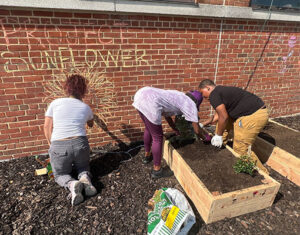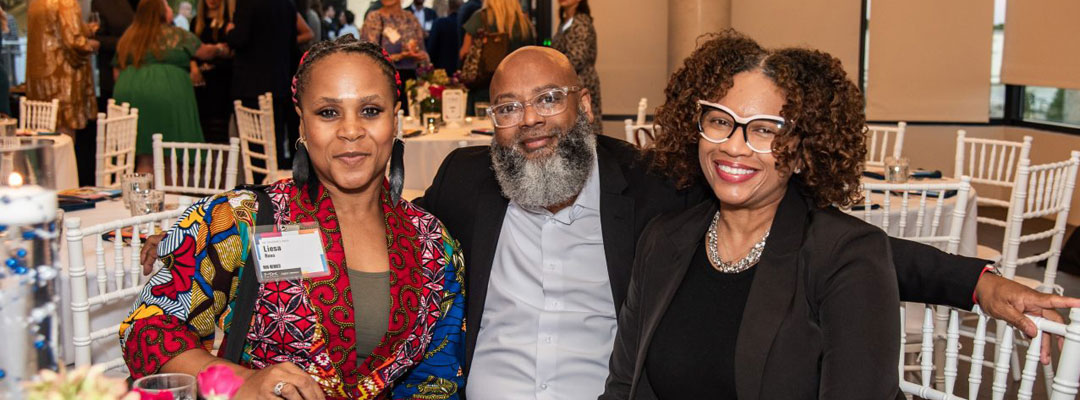 On a bright September day, The Children’s Guild DC Public Charter School students rolled up their sleeves for an exciting project—Beautification Day, a hands-on initiative to create a community garden on their school grounds. Thanks to a generous grant from the Scott’s GroMoreGood Grassroots Program, the students are not only helping to beautify their school but are also planting the seeds for a healthier, greener future.
On a bright September day, The Children’s Guild DC Public Charter School students rolled up their sleeves for an exciting project—Beautification Day, a hands-on initiative to create a community garden on their school grounds. Thanks to a generous grant from the Scott’s GroMoreGood Grassroots Program, the students are not only helping to beautify their school but are also planting the seeds for a healthier, greener future.
TCGDC is proud to have received the GroMoreGood Grassroots Grant, a national program aimed at bringing the joy and benefits of gardening to communities across the United States. The partnership between The Scotts Miracle-Gro Foundation and KidsGardening provides garden grants, kits, educational curriculum, and training for youth gardens and Head Start programs. This support aligns perfectly with TCGDC’s vision of creating a safe, green space where students can thrive.
The new garden, part of the school’s Project Sunflower, is the brainchild of Molly Fleder, LMSW, Elementary Social Worker, and Horticultural Therapist at TCGDC. “We are excited to receive this grant from Scott’s GroMoreGood Program to create a new garden at our DC school,” said Fleder. “The youth in our community face many challenges due to the social and economic hardships of Washington, D.C.’s 7th and 8th wards. This grant will help provide safe, accessible green spaces, offering students opportunities for outdoor recreation, physical activity, and connecting with nature.”
The mission of Project Sunflower is to create a nurturing and inclusive environment where students can achieve their individualized educational goals while fostering social, emotional, sensory, cognitive, and imaginative growth. The garden will serve as more than just a place for plants to grow—it will become an outdoor classroom, therapy space, and hands-on learning lab for the students.
 Principal Frank Medley of TCGDC expressed his pride in the students’ enthusiasm during Beautification Day. “It warms my heart that students are giving 110% and showing they really love their school,” said Medley. “In our district, a lot of students do not have any green space, so this garden represents a huge opportunity for them. After planting, students will manage the garden, water the plants, measure how high they grow, and integrate the program into their science lessons.”
Principal Frank Medley of TCGDC expressed his pride in the students’ enthusiasm during Beautification Day. “It warms my heart that students are giving 110% and showing they really love their school,” said Medley. “In our district, a lot of students do not have any green space, so this garden represents a huge opportunity for them. After planting, students will manage the garden, water the plants, measure how high they grow, and integrate the program into their science lessons.”
The involvement of the students extends beyond planting. They will actively engage with the garden throughout the year, working with their social worker or teacher to learn about plant life cycles, pollination, and how ecosystems function. The school received donations of seedlings from the local Arboretum, including a variety of vegetables like broccoli, kale, and collard greens, as well as herbs and flowers such as rosemary, thyme, echinacea, sunflowers, and catmint. These plants not only beautify the garden but will also attract pollinators, contributing to the local ecosystem.
Therapeutic and Educational Benefits for Students
 The garden will offer numerous therapeutic benefits, especially for students with Individualized Educational Plans (IEPs). The program supports students in achieving social and emotional milestones, including enhanced mood, self-accomplishment, and decision-making skills. For students on the Autism Spectrum or with ADHD, the sensory aspects of gardening—touching soil, seeing colors, and smelling herbs—will help with focus, endurance, and occupational therapy goals.
The garden will offer numerous therapeutic benefits, especially for students with Individualized Educational Plans (IEPs). The program supports students in achieving social and emotional milestones, including enhanced mood, self-accomplishment, and decision-making skills. For students on the Autism Spectrum or with ADHD, the sensory aspects of gardening—touching soil, seeing colors, and smelling herbs—will help with focus, endurance, and occupational therapy goals.
Cognitively, the garden encourages focus and memory retention, while discovery and imagination are nurtured as students explore the changing seasons and the life cycles of plants and animals. From watching caterpillars transform into butterflies to planting and harvesting crops, students will connect what they learn in the garden to their classroom studies.
A Holistic Approach to Education
 Throughout the year, the garden will be a central part of TCGDC’s educational approach, providing a space where students can apply lessons from science, math, and even special education in real-world, hands-on activities. Weekly visits to the garden will include group therapy sessions, classroom projects, and individual therapy tailored to each student’s IEP.
Throughout the year, the garden will be a central part of TCGDC’s educational approach, providing a space where students can apply lessons from science, math, and even special education in real-world, hands-on activities. Weekly visits to the garden will include group therapy sessions, classroom projects, and individual therapy tailored to each student’s IEP.
As the garden grows, so will the students’ knowledge, confidence, and sense of accomplishment. The project represents a holistic approach to education—one that nurtures the body, mind, and spirit while connecting students to the natural world.
To learn more about The Children’s Guild DC Public Charter School go to www.tcgdc.org
 During this season of giving, The Children’s Guild (TCG) is striving to advance The Power of Possibility by raising $25,000 to enhance special education services.
During this season of giving, The Children’s Guild (TCG) is striving to advance The Power of Possibility by raising $25,000 to enhance special education services.

 At The Children’s Guild, we’re thrilled to introduce two outstanding new leaders who are ready to make a profound impact on our mission to serve children and families across the Mid-Atlantic: Andrew “Andy” Simone as our new Chief Financial Officer (CFO) and Dawn RobertsMark as our new Managing Director of Program Operations.
At The Children’s Guild, we’re thrilled to introduce two outstanding new leaders who are ready to make a profound impact on our mission to serve children and families across the Mid-Atlantic: Andrew “Andy” Simone as our new Chief Financial Officer (CFO) and Dawn RobertsMark as our new Managing Director of Program Operations. Dawn RobertsMark, our new Managing Director of Program Operations, is equally passionate about our mission. With a background in education and extensive experience in teacher development, school leadership, and Restorative Practices, Dawn has a strong commitment to fostering inclusive and equitable learning environments. She believes in the power of nurturing student achievement and staff development, values that align beautifully with our work here at The Children’s Guild.
Dawn RobertsMark, our new Managing Director of Program Operations, is equally passionate about our mission. With a background in education and extensive experience in teacher development, school leadership, and Restorative Practices, Dawn has a strong commitment to fostering inclusive and equitable learning environments. She believes in the power of nurturing student achievement and staff development, values that align beautifully with our work here at The Children’s Guild. On a bright September day,
On a bright September day,  Principal Frank Medley of TCGDC expressed his pride in the students’ enthusiasm during Beautification Day. “It warms my heart that students are giving 110% and showing they really love their school,” said Medley. “In our district, a lot of students do not have any green space, so this garden represents a huge opportunity for them. After planting, students will manage the garden, water the plants, measure how high they grow, and integrate the program into their science lessons.”
Principal Frank Medley of TCGDC expressed his pride in the students’ enthusiasm during Beautification Day. “It warms my heart that students are giving 110% and showing they really love their school,” said Medley. “In our district, a lot of students do not have any green space, so this garden represents a huge opportunity for them. After planting, students will manage the garden, water the plants, measure how high they grow, and integrate the program into their science lessons.” The garden will offer numerous therapeutic benefits, especially for students with
The garden will offer numerous therapeutic benefits, especially for students with  Throughout the year, the garden will be a central part of TCGDC’s educational approach, providing a space where students can apply lessons from science, math, and even special education in real-world, hands-on activities. Weekly visits to the garden will include group therapy sessions, classroom projects, and individual therapy tailored to each student’s IEP.
Throughout the year, the garden will be a central part of TCGDC’s educational approach, providing a space where students can apply lessons from science, math, and even special education in real-world, hands-on activities. Weekly visits to the garden will include group therapy sessions, classroom projects, and individual therapy tailored to each student’s IEP.








